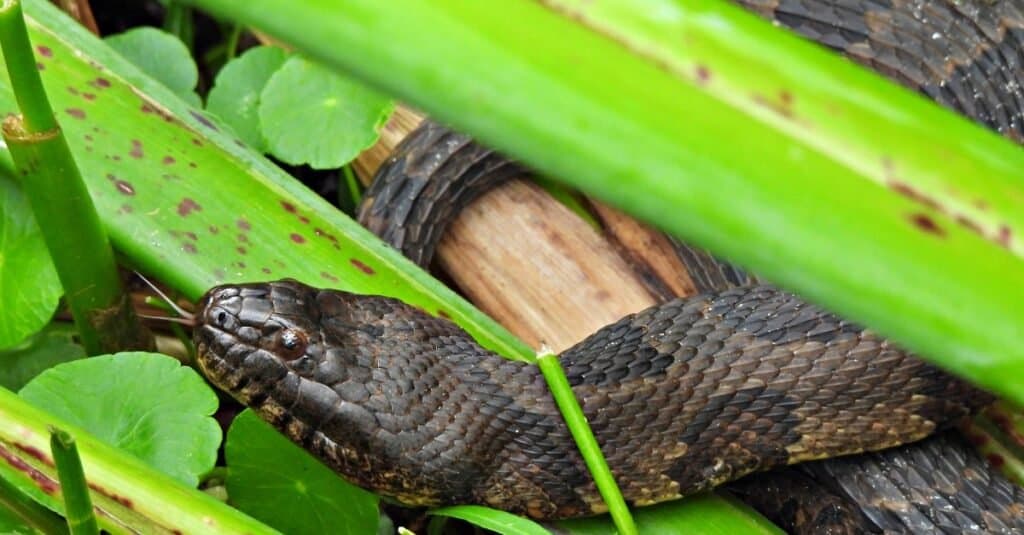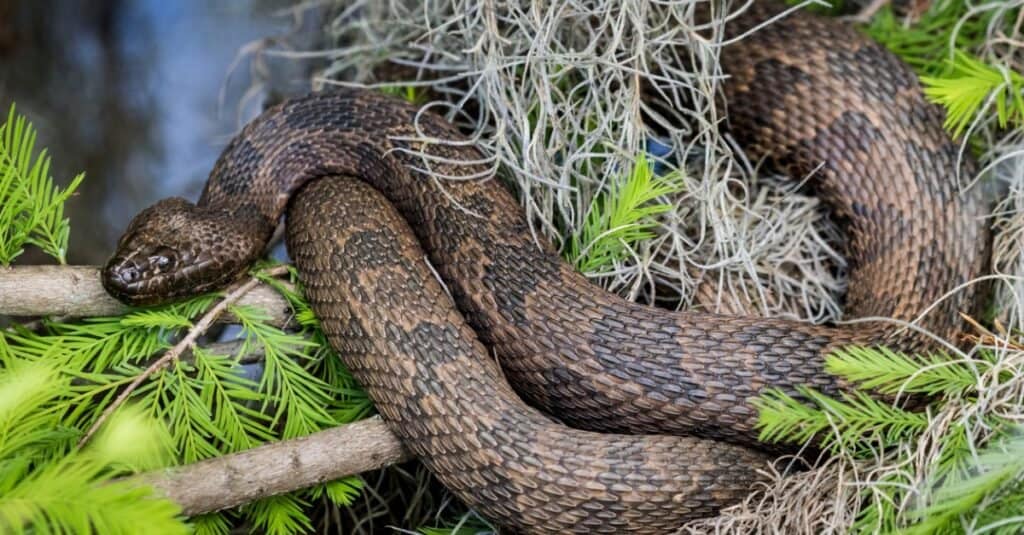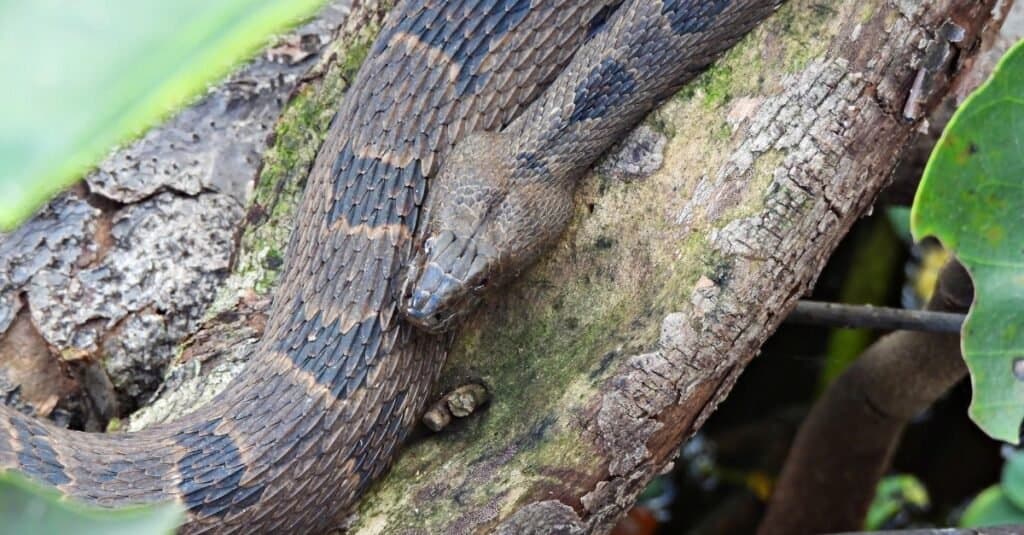Discover the Largest Brown Water Snake Ever Recorded
The brown water snake is also known as aspic, false moccasin, the great water snake, water rattle, and many other names in different regions of the United States. It is a non-venomous aquatic species with a preference for freshwater habitats. Unfortunately, it is often mistaken for the dangerous water moccasin snake indigenous to the same region; and is therefore indiscriminately killed. Brown water snakes are relatively large, ranging from 30 to 60 inches. But some species have been found to grow larger! In this article, you’ll discover the largest brown water snake ever recorded.
What Do Brown Water Snakes Look like?

iStock.com/passion4nature
The brown water snake (Nerodia taxispilota) is a large non-venomous snake endemic to the southeastern United States. This highly aquatic snake is often one of the most abundant snakes found in rivers and streams of the southeastern United States.
The brown water snake is very heavy-bodied, with most adult species measuring about 30-60 inches in total length. It is a stout-bodied snake with a large head, and its neck is narrower and more distinct from its head. As its name depicts, the coloration of its dorsum ranges from light tan to brown, with a row of about 25 squarish black or darker brown blotches down the middle of its back. Smaller similar blotches extend from the belly onto the sides of the body, alternating between the markings on the back. Ventrally, it is yellowish and heavily marked with irregular patterns of black or dark brown patches. Juvenile coloration and pattern are identical to that of adults. An interesting feature of brown water snakes is the presence of dorsal scales arranged in 27-33 rows – which is more than any other North American water snake.
Range and Habitat of the Brown Water Snake

iStock.com/csraphotography
The brown water snake’s range extends through the lower coastal regions from southeastern Virginia, South Carolina, North Carolina, and Georgia to Florida, then west through Alabama, Missouri, Mississippi, and Louisiana. In Florida, brown water snakes are found throughout mainland Florida in every county but are only absent from the Florida Keys.
The brown water snake is a highly aquatic species associated with large bodies of water, especially swamps, rivers, and streams, which is why it is often mistaken for a moccasin. It is commonly found in reservoirs, ponds, cypress strands, sawgrass prairies, canals, lakes, marshes around bays, and flooded stands of melaleuca. These snakes are usually associated with open stretches of water with overhanging vegetation. Adults and juveniles of this species are sometimes found in suburban neighborhoods where development encroaches into favorable habitats.
What is the Largest Brown Water Snake Ever Recorded?

iStock.com/passion4nature
Adults of this species grow up to approximately 30–60 inches (76–152 cm) in total length. A few species have been found to grow larger than this average length. The largest brown water snake ever recorded was found to be about 177.8 centimeters long (70 inches). Another large, heavy-bodied brown water snake reaching a maximum total length of 176.6 cm (69.5 inches) was recorded by Conant and Collins in 1991. In Virginia, the maximum total length was documented by Werler and McCallion to be 68.7 inches (174.5 inches).
Behavior of the Brown Water Snake
Water snakes are typically diurnal; they are active during the day during the spring and fall, but they may become nocturnal during the hot summer months. Their activity times may also change with seasons; because they frequently bask on logs and overhanging vegetation during midday in spring and fall. But in the summer, they only do this in the mornings. Generally, brown water snakes are active from April through November.
How Dangerous Are Brown Water Snakes?
Brown water snakes are non-venomous and are therefore not dangerous to people or pets. When approached, they will naturally react by fleeing into the water and diving below the surface because they prefer to avoid direct contact with people and pets. Though if grabbed or cornered, they will readily bite the attacker to defend themselves. A large one can inflict a nasty wound from its long teeth. They’re also known to release a foul-smelling musk from a pair of glands in the base of their tail as a defensive behavior. Normally, these snakes are not aggressive; striking is only used in defense as a last resort. Almost all bites from brown water snakes occur when the snakes are intentionally molested.
How Do Brown Water Snakes Reproduce?
Breeding occurs once a year for female brown water snakes, usually between February and May. This species is ovoviviparous, meaning they give birth to live young ones (in broods of 14–58, more commonly 30–40). On average, adult females are larger than adult males. The newborn water snakes are 7-10¾ inches (18–27 cm) long, but males are longer than females, opposite adults. In Florida, females typically give birth to live 4 to 61 young ones, usually in late summer or early fall. In Virginia, the average number of neonates for females at full-term was 28.
What Do Brown Water Snakes Eat?
A published study of the ecology of brown water snakes indicates that they are piscivorous and feed almost exclusively on freshwater fishes, especially catfishes. They overpower prey by grabbing it in their jaws, hauling it to shore, and swallowing it whole after it has been subdued.
Similar Species: What Snakes Look Like Brown Water Snakes?
The brown water snake is often mistaken for other similar species because they live in the same habitat or have identical appearances. Some of these species often confused with brown water snakes are;
Florida Cottonmouth
Unlike the brown water snake, the Florida cottonmouth is a venomous species. To differentiate the two species, be aware that if the head is viewed from above, the eyes of cottonmouths are not visible, while the eyes of water snakes can be seen. Another difference is that cottonmouths have vertically elliptical or cat-like pupils, whereas water snakes have round pupils. Cottonmouths also have a facial pit between the nostril and the eye, whereas watersnakes do not.
Southern Watersnake
The non-venomous southern water snake has broad black, brown, or red crossbands (often rimmed with black) down the back and a dark line that extends from the eye to the angle of the jaw.
Saltmarsh Watersnake
Another similar species, the non-venomous saltmarsh watersnakes, often have several dark stripes running along their body. They are usually only found in saltwater and brackish coastal habitats.
Midland Watersnake
The non-venomous Midland water snake is smaller and has more than 30 complete darker brown crossbands down the anterior body. Its belly is yellowish and marked with two rows of half-moons.
Discover the “Monster” Snake 5X Bigger than an Anaconda
Every day A-Z Animals sends out some of the most incredible facts in the world from our free newsletter. Want to discover the 10 most beautiful snakes in the world, a “snake island” where you’re never more than 3 feet from danger, or a “monster” snake 5X larger than an anaconda? Then sign up right now and you’ll start receiving our daily newsletter absolutely free.
More from A-Z Animals
The brown water snake is also known as aspic, false moccasin, the great water snake, water rattle, and many other names in different regions of the United States. It is a non-venomous aquatic species with a preference for freshwater habitats. Unfortunately, it is often mistaken for the dangerous water moccasin snake indigenous to the same region; and is therefore indiscriminately killed. Brown water snakes are relatively large, ranging from 30 to 60 inches. But some species have been found to grow larger! In this article, you’ll discover the largest brown water snake ever recorded.
What Do Brown Water Snakes Look like?

iStock.com/passion4nature
The brown water snake (Nerodia taxispilota) is a large non-venomous snake endemic to the southeastern United States. This highly aquatic snake is often one of the most abundant snakes found in rivers and streams of the southeastern United States.
The brown water snake is very heavy-bodied, with most adult species measuring about 30-60 inches in total length. It is a stout-bodied snake with a large head, and its neck is narrower and more distinct from its head. As its name depicts, the coloration of its dorsum ranges from light tan to brown, with a row of about 25 squarish black or darker brown blotches down the middle of its back. Smaller similar blotches extend from the belly onto the sides of the body, alternating between the markings on the back. Ventrally, it is yellowish and heavily marked with irregular patterns of black or dark brown patches. Juvenile coloration and pattern are identical to that of adults. An interesting feature of brown water snakes is the presence of dorsal scales arranged in 27-33 rows – which is more than any other North American water snake.
Range and Habitat of the Brown Water Snake

iStock.com/csraphotography
The brown water snake’s range extends through the lower coastal regions from southeastern Virginia, South Carolina, North Carolina, and Georgia to Florida, then west through Alabama, Missouri, Mississippi, and Louisiana. In Florida, brown water snakes are found throughout mainland Florida in every county but are only absent from the Florida Keys.
The brown water snake is a highly aquatic species associated with large bodies of water, especially swamps, rivers, and streams, which is why it is often mistaken for a moccasin. It is commonly found in reservoirs, ponds, cypress strands, sawgrass prairies, canals, lakes, marshes around bays, and flooded stands of melaleuca. These snakes are usually associated with open stretches of water with overhanging vegetation. Adults and juveniles of this species are sometimes found in suburban neighborhoods where development encroaches into favorable habitats.
What is the Largest Brown Water Snake Ever Recorded?

iStock.com/passion4nature
Adults of this species grow up to approximately 30–60 inches (76–152 cm) in total length. A few species have been found to grow larger than this average length. The largest brown water snake ever recorded was found to be about 177.8 centimeters long (70 inches). Another large, heavy-bodied brown water snake reaching a maximum total length of 176.6 cm (69.5 inches) was recorded by Conant and Collins in 1991. In Virginia, the maximum total length was documented by Werler and McCallion to be 68.7 inches (174.5 inches).
Behavior of the Brown Water Snake
Water snakes are typically diurnal; they are active during the day during the spring and fall, but they may become nocturnal during the hot summer months. Their activity times may also change with seasons; because they frequently bask on logs and overhanging vegetation during midday in spring and fall. But in the summer, they only do this in the mornings. Generally, brown water snakes are active from April through November.
How Dangerous Are Brown Water Snakes?
Brown water snakes are non-venomous and are therefore not dangerous to people or pets. When approached, they will naturally react by fleeing into the water and diving below the surface because they prefer to avoid direct contact with people and pets. Though if grabbed or cornered, they will readily bite the attacker to defend themselves. A large one can inflict a nasty wound from its long teeth. They’re also known to release a foul-smelling musk from a pair of glands in the base of their tail as a defensive behavior. Normally, these snakes are not aggressive; striking is only used in defense as a last resort. Almost all bites from brown water snakes occur when the snakes are intentionally molested.
How Do Brown Water Snakes Reproduce?
Breeding occurs once a year for female brown water snakes, usually between February and May. This species is ovoviviparous, meaning they give birth to live young ones (in broods of 14–58, more commonly 30–40). On average, adult females are larger than adult males. The newborn water snakes are 7-10¾ inches (18–27 cm) long, but males are longer than females, opposite adults. In Florida, females typically give birth to live 4 to 61 young ones, usually in late summer or early fall. In Virginia, the average number of neonates for females at full-term was 28.
What Do Brown Water Snakes Eat?
A published study of the ecology of brown water snakes indicates that they are piscivorous and feed almost exclusively on freshwater fishes, especially catfishes. They overpower prey by grabbing it in their jaws, hauling it to shore, and swallowing it whole after it has been subdued.
Similar Species: What Snakes Look Like Brown Water Snakes?
The brown water snake is often mistaken for other similar species because they live in the same habitat or have identical appearances. Some of these species often confused with brown water snakes are;
Florida Cottonmouth
Unlike the brown water snake, the Florida cottonmouth is a venomous species. To differentiate the two species, be aware that if the head is viewed from above, the eyes of cottonmouths are not visible, while the eyes of water snakes can be seen. Another difference is that cottonmouths have vertically elliptical or cat-like pupils, whereas water snakes have round pupils. Cottonmouths also have a facial pit between the nostril and the eye, whereas watersnakes do not.
Southern Watersnake
The non-venomous southern water snake has broad black, brown, or red crossbands (often rimmed with black) down the back and a dark line that extends from the eye to the angle of the jaw.
Saltmarsh Watersnake
Another similar species, the non-venomous saltmarsh watersnakes, often have several dark stripes running along their body. They are usually only found in saltwater and brackish coastal habitats.
Midland Watersnake
The non-venomous Midland water snake is smaller and has more than 30 complete darker brown crossbands down the anterior body. Its belly is yellowish and marked with two rows of half-moons.
Discover the “Monster” Snake 5X Bigger than an Anaconda
Every day A-Z Animals sends out some of the most incredible facts in the world from our free newsletter. Want to discover the 10 most beautiful snakes in the world, a “snake island” where you’re never more than 3 feet from danger, or a “monster” snake 5X larger than an anaconda? Then sign up right now and you’ll start receiving our daily newsletter absolutely free.







